Content for TS 23.222 Word version: 19.3.0
0…
4…
5…
6…
6.3…
6.4…
7…
8…
8.5…
8.8…
8.9…
8.13…
8.17…
8.21…
8.25…
8.26…
8.28…
8.30…
9…
10…
10.4…
10.7…
11…
A
B…
B.2…
B.3…
C…
D…
6 Functional model
6.1 General
6.2 Functional model description
6.2.0 Functional model description for the CAPIF
6.2.1 Functional model description to support 3rd party API providers
6.2.2 Functional model description to support CAPIF interconnection
6.2.3 Functional model description to support RNAA
...
...
6 Functional model p. 23
6.1 General p. 23
The Common API framework (CAPIF) functional architecture is described in this subclause. The CAPIF architecture is defined as service-based and interactions between the CAPIF functions are represented in two ways:
- A service-based representation, where CAPIF functions enable other authorized CAPIF functions to access their services;
- A reference point representation, where interactions between any two CAPIF functions (e.g. CCF, AEF) is shown by an appropriate point-to-point reference point (e.g. CAPIF-3).
6.2 Functional model description p. 24
6.2.0 Functional model description for the CAPIF |R16| p. 24
Figure 6.2.0-1 shows the reference point based functional model for the CAPIF.
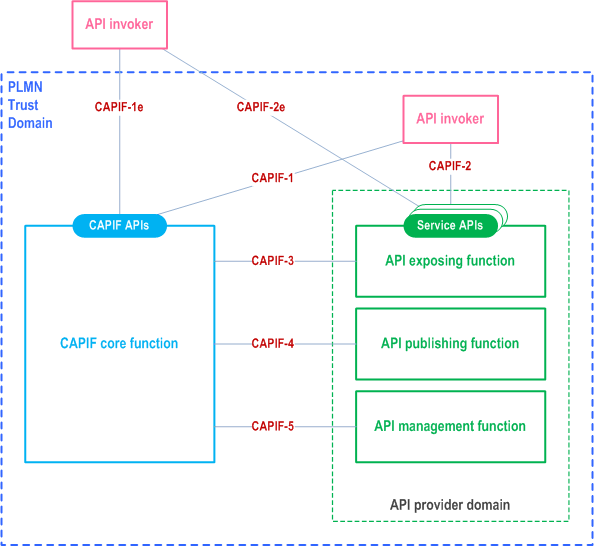
The CAPIF is hosted within the PLMN operator network (or even an SNPN). The API invoker is typically provided by a 3rd party application provider who has service agreement with PLMN operator. The API invoker may reside within the same trust domain as the PLMN operator network.
In a reference point based model, the API invoker within the PLMN trust domain interacts with the CAPIF via CAPIF-1 and CAPIF-2. The API invoker from outside the PLMN trust domain interacts with the CAPIF via CAPIF-1e and CAPIF-2e. The API exposing function, the API publishing function and the API management function of the API provider domain (together known as API provider domain functions) within the PLMN trust domain interacts with the CAPIF core function via CAPIF-3, CAPIF-4 and CAPIF-5 respectively.

As illustrated in Figure 6.2.0-2, the interactions between the API exposing functions within the PLMN trust domain is via CAPIF-7.
The CAPIF core function provides CAPIF APIs to the API invoker over CAPIF-1 and CAPIF-1e. The API exposing function provides the service APIs to the API invoker over CAPIF-2 and CAPIF-2e.
The detailed information of the APIs provided by the CAPIF core function is specified in clause 10.
The security aspects of CAPIF reference points are specified in TS 33.122.
Figure 6.2.0-3 illustrates the CAPIF functional model using service-based interfaces.
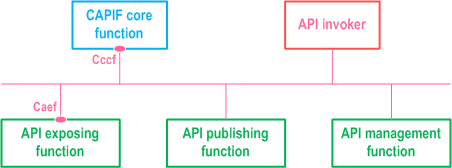
Table 6.2.0-1 specifies the service-based interfaces supported by CAPIF.
| Service-based interface | Entity | APIs offered |
|---|---|---|
| Cccf | CAPIF core function | Specified in subclause 10 |
| Caef | API exposing function | Specified in subclause 11 |
6.2.1 Functional model description to support 3rd party API providers |R16| p. 26
Figure 6.2.1-1 shows the functional model for the CAPIF to support 3rd party API providers.
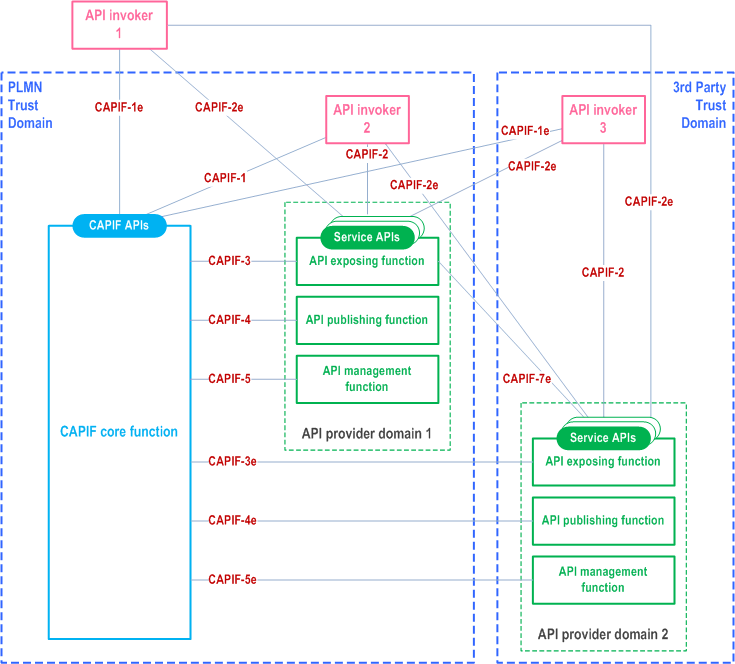
The CAPIF core function in the PLMN trust domain supports service APIs from both the PLMN trust domain and the 3rd party trust domain having business relationship with PLMN. The API invokers may exist within the PLMN trust domain, or within the 3rd party trust domain or outside of both the PLMN trust domain and the 3rd party trust domain. The API provider domain 1 offers the service APIs from the PLMN operator. The API provider domain 2 offers the service APIs from the 3rd party. When the 3rd party API provider is a trusted 3rd party of the PLMN, the API provider domain 1 also offers the service APIs from the 3rd party.
The API invoker 2 within the PLMN trust domain interacts with the CAPIF core function via CAPIF-1, and invokes the service APIs in the PLMN trust domain via CAPIF-2 and invokes the service APIs in the 3rd party trust domain via CAPIF-2e. The API invoker 3 within the 3rd party trust domain interacts with the CAPIF core function via CAPIF-1e, and invokes the service APIs in the PLMN trust domain via CAPIF-2e and invokes the service APIs in 3rd party trust domain via CAPIF-2. The API invoker 1 from outside the PLMN trust domain and 3rd party trust domain, interacts with the CAPIF core function via CAPIF-1e and invokes the service APIs in the PLMN trust domain and the service APIs in the 3rd party trust domain via CAPIF-2e.
The API exposing function, the API publishing function and the API management function of the API provider domain 1 within the PLMN trust domain interacts with the CAPIF core function via CAPIF-3, CAPIF-4 and CAPIF-5 respectively. The API exposing function, the API publishing function and the API management function of the API provider domain 2 within the 3rd party trust domain interacts with the CAPIF core function in the PLMN trust domain via CAPIF-3e, CAPIF-4e and CAPIF-5e respectively. The API exposing function within the PLMN trust domain and the 3rd party trust domain provides the service APIs to the API invoker, offered by the respective trust domains.
The interactions between the API exposing functions within the PLMN trust domain is via CAPIF-7 (not shown in the Figure 6.2.1-1 for simplicity). The API exposing function within the PLMN trust domain interacts with the API exposing function in the 3rd party trust domain via CAPIF-7e.
The detailed information of the APIs provided by the CAPIF core function is specified in clause 10.
6.2.2 Functional model description to support CAPIF interconnection |R16| p. 27
Figure 6.2.2-1 shows the architectural model for the CAPIF interconnection which allows API invokers of a CAPIF provider to utilize the service APIs from the 3rd party CAPIF provider.
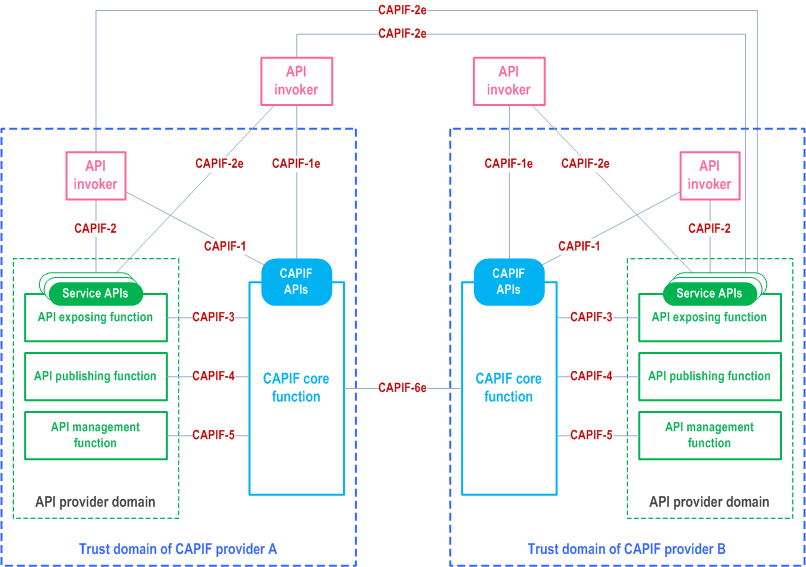
Figure 6.2.2-2 shows the architectural model for the CAPIF interconnection within the same CAPIF provider domain, which allows API invokers of CAPIF core function 1 to utilize the service APIs from CAPIF core function 2, where both CAPIF core function 1 and CAPIF core function 2 are hosted within the trust domain of the CAPIF provider A.
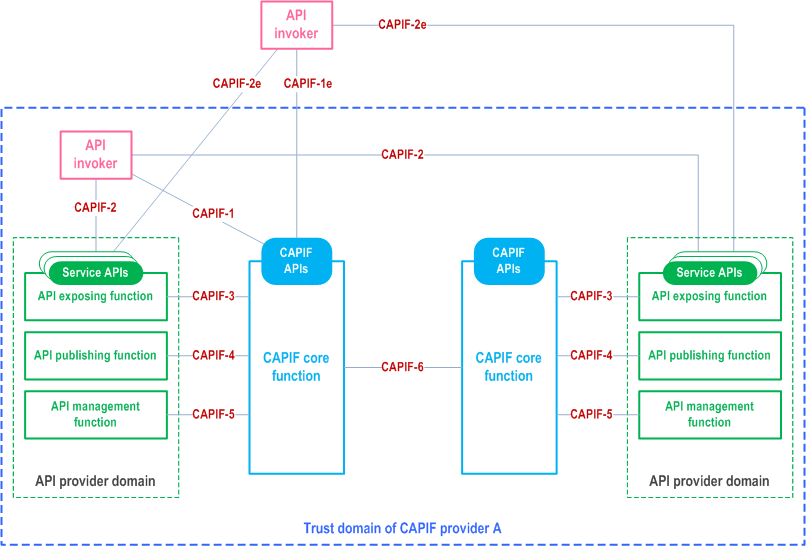
The CAPIF provider A and CAPIF provider B host the CAPIF in their trust domains. A business relationship exists between the CAPIF providers.
The CAPIF providers in their respective trust domain hosts multiple CAPIF instances where each CAPIF instance consists of the CAPIF core function (local), the API provider domain and the API invokers. All interactions within the CAPIF instance is according to the functional model specified in clause 6.2.0.
When multiple CAPIF instances are deployed by a CAPIF provider there may be a hierarchy associated with the multiple CAPIF core function deployed which allows:
- the designated CAPIF core function of the CAPIF provider A to interconnect with the designated CAPIF core function of the CAPIF provider B; and
- within CAPIF provider A, one or more CAPIF core function interacts with the designated CAPIF core function 1.
6.2.3 Functional model description to support RNAA |R18| p. 29
Figure 6.2.3-1 shows the architectural model for the RNAA which allows the resource owner to provide authorization to the API invocation.
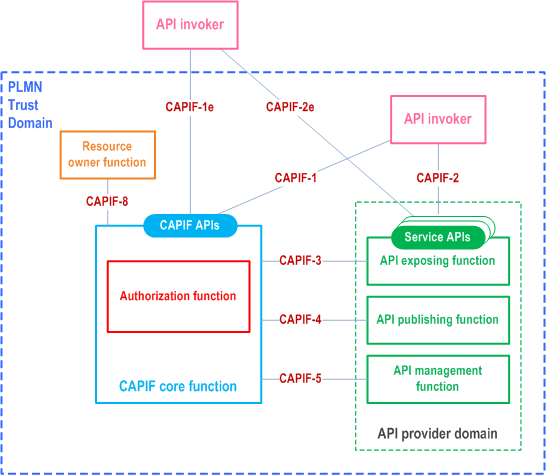
The authorization function is an internal entity of the CAPIF core function.
The resource owner function interacts with the authorization function in the CAPIF core function via CAPIF-8. The resource owner function communicates with the authorization function in the CAPIF core function to manage resource owner consent. The CAPIF core function (authorization function) manages the consent information.
The API exposing function (e.g. NEF, SCEF) acts as a resource owner consent enforcement point and interacts with the authorization function in the CAPIF core function via CAPIF-3. The API exposing function can retrieve the resource owner consent parameters from the authorization function.
The API invoker interacts with authorization function in the CAPIF core function via CAPIF-1/CAPIF-1e.
The security aspects of CAPIF supporting RNAA are specified in TS 33.122.